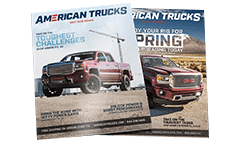Guaranteed Free Delivery by 12/24! available on most items - Details
How to Lift Your Truck
Want to stand out from the herd of stock pickups out on the highways? You could bolt a giant wing to the roof of your rig, but that'll probably get you the wrong kind of gawk. Instead, trick out your truck's suspension with a lift kit. Lift kits come in two formats: a body lift kit and a suspension lift kit. It kind of goes without saying, but a body lift kit raises the body on a stock suspension system while a suspension lift kit raises the body and frame by altering the height of the suspension components. Unlike older lift kits, current models are custom-configured to each make, model and year and engineered to bolt directly onto your stock suspension without any modification. Forget about dusting off your plasma cutter and TIG welder— just mount the torsion keys, spacers, caps or blocks, and you're set. However, given the weights and forces involved, a lift kit can sometimes be tricky to install. That's why it's always handy to have a shop on hand with pros who know what they're doing. But, you can still save a ton of money by buying the parts separately and just paying for the labor (and with a case of beer under your arm, you'd be surprised at how even the cost of labor can drop).
- Remove the old suspension components and body parts.
- Mount the torsion keys, spacers, caps, or blocks as per your lift kit's instructions.
- Install strong shock absorbers compatible with your lift kit.
- Add sway bars to maintain balance and stability.
When you modify the height of your rig with a rear truck lift or front truck lift, the one thing to be aware of is your suspension system. Pairing a lift kit with performance-grade suspension components ensures your rig is strong enough to withstand its new stature. The suspension system in your car or truck supports the weight of the vehicle, its passengers and cargo while allowing the tires and wheels to move up and down to compensate for uneven pavement. In addition, it prevents excessive body squat and dive while accelerating or braking. Most lift kits come with a strong set of shock absorbers, but you'll want to pick some up if they're missing from your kit. Truck shocks and their auto counterparts absorb many of the pitfalls encountered on the average roadway, keeping the ride smooth. Aftermarket shock absorbers renew your vehicle to its fresh-off-the-line performance and are available as custom-fit, universal performance shocks, OEM-style, and even factory replacements, ensuring the perfect match for replacing those worn out or underperforming stock components. Each part is robotically-welded for accuracy and quality construction, specially-tuned to your make, model, and year.
Finally, extra height can bring a loss in balance and stability. Sway bars keep both in check. Sway bars reduce speed-robbing body roll and increase grip on even the tightest corners, making them ideal for performance driving. If you're a do-it-yourselfer, be on the lookout for models that include all the necessary mounting hardware and custom instructions, both of which make installation a whole lot easier. Suspension lift kits can be used in conjunction with truck shocks and sway bars to provide style and performance. For proper balance and safety, make sure you consider upgrading the necessary supporting components when adding on a lift kit.
Conclusion
Adding a lift kit to your truck can be a great way to enhance its appearance and off-road capabilities. Whether you choose a body lift kit or a suspension lift kit, make sure to consider the quality of the components and their compatibility with your vehicle. Upgrading your suspension system, including shocks and sway bars, can help maintain balance and stability. If you're not experienced with installation, seeking professional help can ensure a safe and effective lift kit installation.
